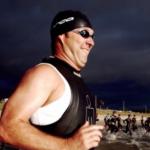
Effortless Swimming
24 July 2017, 6:00AM
HAYDN WOOLLEY
Have you ever noticed how when a good swimmer trains, they look almost effortless? Well, there are two possibilities to explain this – either they are in fact swimming with little or no energy or they are actually masking where the energy is being used. Maybe they are either making it look as if their actions are effortless, but are really doing some hard work.
Well, the truth is that good swimmers blend a mix of both these explanations and that is what this month’s column is going to explore – how to use your energy where it counts so you can maintain good forward speed without it looking hard at all.
A good preface to the discussion is this question: would you ever drive around in your car by constantly accelerating, braking, accelerating, braking? Of course you wouldn’t and we all know why. You would be wasting a large chunk of power by braking which then necessitates a hard acceleration just to get back up to the same speed again. If you did drive like this then most of your power would get cancelled out and the gas tank would be empty in no time. Well it’s the same in the water. It doesn’t make any sense to pull hard with each stroke but then allow yourself to slow down so completely that you stall. If you do, then the amount of energy required to get back up to speed again is phenomenal.
Now check out the diagram below...
The red line is the power signature of an excellent swimmer – you can see their average speed (the flat thick red line) is much higher than the poor swimmer (the flat blue line). The irony of this diagram is that the better swimmer will only be using a fraction of the power of the less effective swimmer, yet be swimming faster and will be able to hold that speed for longer as well. Why is this?
.jpg)
Well, let’s sort our terms out first... the front part of each wave signifies the acceleration up to say a 6km/h level generated by that swimmer’s pull, and both swimmers seem to achieve the same terminal speed level. The top of each curve signifies the length of time the swimmer glides and we can see the better swimmer’s curve is flatter meaning they stay at that speed for longer. Then the downwards part of each curve represents the swimmer’s deceleration before each successive pull.
It is obvious the better swimmer does not need as much power with each pull because they don’t have to climb as high from the lowest to the highest points on their power curve - the downwards curve has not been so steep, i.e. they have not lost very much speed between each stroke. This is one of the big secrets of a good swimmer – they actually don’t require as much power as most people believe because when you keep your speed higher between pulls then each pulling movement only requires a smaller amount of energy. Basically, the central concept here is body position and the elimination of drag. This is why all good coacheswill first focus on this concept before instructing a swimmer on the subject of power – there is no point developing a better pull if you are constantly throwing it away.
Now some of learning this is feel, flow and rhythm which is difficult to learn sometimes because of its intangible and abstract nature. But over time you do learn the feel of when you need to start pulling before you slow down too much. A flexible swimmer with a good kick and ability to maintain a long rigid shape between strokes will always be able to stay at a higher speed even if in the glide for a while. They simply do not slow down quite as fast or as much. If you are one of those swimmers who lack these fundamentals then unfortunately you will initially need to keep your average cadence higher than better swimmers to keep your average speed at a reasonable level. And that will use more energy. But over time you do need to force change by testing how long you can stay in a glide before stalling with exaggerated DPS sets. I am sure we have all experienced these in squad training before.
So there lies the secret and the goal for the next couple of months. Aim to figure out just how much you are stalling in your stroke between pulling movements, and then gradually make adjustments so that your glide does become longer without affecting your forward speed.
There is always a very strong correlation between low stroke counts and faster swimmers!
Good luck with all your training programmes and remember...
TECHNIQUE SETS THE UPPER LIMIT TO WHERE YOUR FITNESS WILL TAKE YOU
